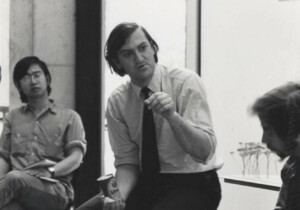John Hejduk will be portrayed in a new light at The Cooper Union later this month where seven works from the architect will be on display, both inside and out.
“Hejduk was often criticized for work lacking social or political relevance,” James Williamson, Dean and Professor Office of the Dean College of Architecture Texas Tech University told The Architect’s Newspaper (AN). “These objects reveal how misconceived such a judgment was,” he added, referring to Hejduk’s Jan Palach Memorial which will be on display.
Born in New York to Czech parents, Hejduk (1929–2000) was the founding dean of The Irwin S. Chanin School of Architecture at The Cooper Union, a post he held for 25 years. He is highly regarded for his contribution to the discipline in terms of both pedagogy and design and the upcoming exhibition strives to reflect the dual elements of his practice. Forty-three photographs by Hélène Binet, Hejduk’s photographer of record, can be seen inside The Cooper Union, and Hejduk’s Jan Palach Memorial will be exhibited outside as part of the New York City Department of Transportation’s (DOT) Art Program in nearby Cooper Square Park.
The Jan Palach Memorial, one of Hejduk’s most provocative sociopolitical works, comprises two structures: House of the Suicide and House of the Mother of the Suicide, both of which include 49 spikes erected onto timber cuboids. The pieces memorialize Jan Palach, a Czech dissident who set himself on fire in 1968 to protest the Soviet invasion of Czechoslovakia. Today, the political overtones of the work are poignant. “Given what is going on right now, both in this country and globally, it’s even more relevant,” said Steven Hillyer, director the architecture school’s archive.
The outdoor installation is a fitting precursor to Binet’s photographic work inside: “You can never compete with a physical experience of a building,” she said. “I show details so the audience can dream about the rest and relate to the human-scale objects. Let’s dream about [Hejduk’s] dream, rather than feeding the audience objects.” Binet prefers black-and-white film for the limitations the analog format provides, parameters that, she says, pushes her creatively.
Works featured range in scale and include The Collapse of Time, the Berlin Tower, and the Wall House II in Groningen, the Netherlands. Binet explained how her photographic work progressed while she worked with Hejduk. She cited his method of “teaching through osmosis,” the “social contract” Hejduk established with his students. She worked with Hillyer to reflect this pedagogical approach, too.
Nader Tehrani, incumbent dean at the school of architecture, expanded on the influence of Hejduk’s teaching style.
“On the one hand, he brought disciplinary projects to the table that had deep histories, and on the other, he brought individuated attention to students’ independent platforms of thinking, such that he could leave latitude for creative and intellectual development outside of his own ideological predispositions,” he said. “The small scale of Cooper Union enabled him to bring forth a more ‘precise’ culture, where craft, making, and representational tools were diversified, and where their instrumentality was put to focus. It is hard to imagine an intellectual figure who has had the ability to produce so many other critical voices: teacher, practitioners, deans, and activists, the very many who now occupy key positions at other reputed institutions.”
The exhibition will be on view March 29 through April 29, 2017 in the Arthur A. Houghton Jr. Gallery at Cooper Union. Visitors will have more time to take in the Jan Palach Memorial, which will be displayed until June 11. “We are hoping,” said Hillyer, “that this will be the first of many installations realized by the school.”










